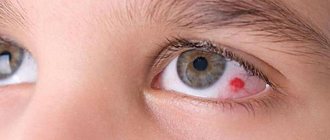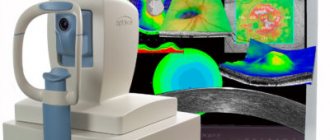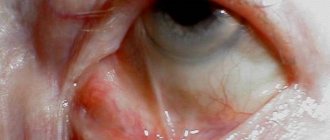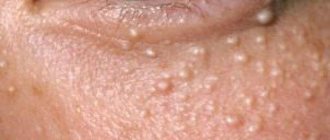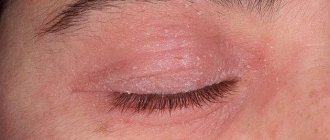Ophthalmoherpes is a lesion of the eyeball or appendages of the eye, which is caused by the herpes simplex virus type 1 or 2.
The share of diseases on the organs of vision among all pathologies is more than 75%.
3–5 relapses per year are possible. Up to 90% of eye lesions occur long after the initial infection.
Serovar HSV 1 penetrates into the eye tissue through neurogenic, exogenous and hematogenous routes. The further development of the disease is indicated by both the biological properties of HSV and the specific immune response of the body. The causative agent of the infectious disease can remain for life in the 5th pair of cranial nerves, the transparent outer membrane of the eye, the salivary and lacrimal glands.
Causes of ocular herpes
Most people are exposed to HSV during childhood and carry the dormant (inactive) virus in their bodies throughout their lives.
HSV types 1 and 2 are not the same virus that causes genital herpes, and herpes eye disease is not considered a sexually transmitted disease.
In most cases, infection occurs with HSV type 1. HSV type 2 rarely causes eye symptoms. But it causes genital herpes.
Another causative agent of ocular herpes is cytomegalovirus.
Varicella zoster virus (VZV), known as human herpes virus-3 (HHV-3), develops when exposed to concomitant factors:
- age - half of the cases occur under the age of 60 years;
- immune compromise - presence of HIV/AIDS, medical immunosuppression;
- exposure to ionizing radiation;
- impaired functioning of the endocrine system;
- the presence of malignant tumors.
Some countries (eg, United States of America, Canada, Australia, Japan, Germany, Russian Federation) vaccinate children against chickenpox. This protects not only from chickenpox, but also from herpes zoster.
In the UK, this vaccination is only offered to children who are particularly vulnerable to chickenpox, such as those undergoing chemotherapy
In some countries (eg, the United States), the herpes zoster vaccination is offered to adults over 60 years of age. Public health introduced herpes zoster vaccination for people aged 70 years in 2013.
What is herpes?
Almost 90% of people are infected with the herpes virus. However, the disease manifests itself in only 17%. There are about 100 types of herpes, 8 of which can parasitize the human body.
The main symptom is the formation of a rash in the form of blisters. They often appear on the lips, but can be localized on any other part of the body.
When a person is healthy, his immune system copes with the virus, but as soon as he catches a little cold, herpes begins to attack the body. Sometimes signs of virus activation appear near the eyes, on the eyelids. How dangerous is this? Many people have encountered this disease. Some people don't even make any attempt to get rid of the signs of herpes. They often go away on their own as soon as a person recovers from a cold. However, herpes on the eye is a very dangerous disease, since if left untreated, the virus causes severe side effects and causes the development of serious ophthalmological diseases.
It is impossible to completely cure herpes. If it enters the body, which happens through airborne droplets, through contact with household objects, through food, it is no longer possible to get rid of it. The virus will remain dormant in the nerve ganglia until the person becomes ill and his immunity weakens. In this regard, therapy does not eliminate the virus itself, but its symptoms. So, why does herpes occur on the eye, how is it treated and can its occurrence be prevented? Let's take a closer look at these questions.
Risk group
Persons with a weakened immune system and the following groups of patients are susceptible to the occurrence of the disease:
- regularly exposed to hypothermia and stress;
- taking immunosuppressants and cytostatics for a long time;
- women during pregnancy;
- with mechanical injury to the eyeball.
Other risk factors:
- An imbalance of the amino acids arginine and lysine in the body makes people vulnerable. Arginine is needed for the growth of HSV.
- Stress reduces the effectiveness of the immune system.
- Excess sugar increases the risk and severity of the disease.
- People who have suffered from ocular herpes before should avoid arginine.
- Keratoconjunctivitis syndrome is a stressor that contributes to disease outbreaks.
Reasons for appearance
After penetration into the body and spread of infection, symptoms of herpes may be absent for a long time, especially after a preliminary increase in immunity. This is explained by the fact that the harmful virus, penetrating the mucous membrane of the eye, does not multiply under the influence of the interferon produced. Own immunoglobulins contained in the tear fluid inhibit the inflammatory process, as if prolonging the incubation period.
If the immune system is weakened, the pathogenic virus equally affects the cornea and eyelids, accompanied by acute inflammation of the ocular structure of the apple and the optic nerves. Before proceeding to conservative therapy, it is important to study the etiology of the pathological process, identify and exclude factors that provoke ophthalmoherpes. This:
- prolonged hypothermia of the body;
- complicated infectious diseases;
- mechanical and chemical eye injuries;
- long-term use of medications;
- progressive pregnancy;
- prolonged exposure to the sun;
- violation of personal hygiene rules;
- complication of colds, viral diseases;
- stress, chronic fatigue.
Forms of ophthalmoherpes and symptoms
Herpes zoster occurs when the varicella zoster virus, which is dormant in most people, attacks the optic nerve. Spreads to the epithelial layer of the cornea, then to the stroma layer. Anterior uveitis develops in 40–50% of cases. Another characteristic result is skin rashes around the eyes.
The virus first attacks the corneal epithelium, the thin outer layer. It plays an important role in protecting the eyes. Blocks the penetration of foreign materials and provides a smooth surface for the absorption of oxygen and cellular nutrients that are delivered through the tear film. The epithelium contains many nerve endings and is very sensitive.
When a virus attacks the cornea, this outer layer becomes red, irritated and painful because the nerve endings that serve the cornea become infected.
The extent of the damage varies widely, sometimes healing on its own within 7–10 days. However, if the virus recurs recently, the results can be severe, including ulcers and lesions that extend into the stromal layer of the cornea.
The stroma layer is a thick layer consisting of water, layers of protein fibers and cells that provide nutrition.
Herpetic eye disease can be primary (occurs during primary infection), recurrent (development is due to the persistence of HSV), anterior and posterior (the virus affects the corresponding segment of the eye, the anterior one is manifested by conjunctivitis or erosion, the posterior one - by neuritis, retinochoroiditis, acute necrosis syndrome, uveitis and retinopathy) .
Symptoms of the disease depending on the form:
- Herpetic dermatitis has an acute onset. The skin is reddened, transparent blisters appear on the eyelids and burst. Patients report chills, fever, and cephalgia. Before the bubbles appear, itching, burning and tension of the skin are disturbing. Small blisters inside with cloudy contents, they gradually dry out and form crusts. After 1–2 weeks of treatment, the crusts disappear and no scars remain.
- Keratoiridocyclitis takes an acute or recurrent form. The disease is painful, the pain is sharp. There is lacrimation, increased sensitivity to light, and hyperemia. Vision gradually deteriorates. The acute and chronic forms of the disease proceed in the same way, only the latter passes without pain.
- Herpetic conjunctivitis is characterized by swelling of the eyelids and mucous membranes, burning and photophobia, small ulcers, and mucous discharge. There are practically no purulent discharges with this form of the disease; they appear when a bacterial infection is attached.
- Herpetic corneal ulcers are areas of stromal damage. In old age, it is asymptomatic, there is little or no redness. In children and adults, a herpetic ulcer of the cornea is accompanied by severe pain, severe irritation and increased sensitivity to light.
- Stromal keratitis manifests itself as discoid edema of the cornea. Swelling leads to permanent scarring, which causes blurred vision. It is characterized by a foreign body sensation, increased IOP, vascular damage and watery rashes.
- Postherpetic trophic keratitis is manifested by poor sensitivity and thickening of the stratum corneum, the epithelium is rough, the rash passes quickly, but reappears.
How does herpes around the eye manifest?
The symptoms of ophthalmoherpes may vary depending on the type of virus. Signs of the disease depend on the form and location of herpes. If it occurs under the eye or on the eyelid, the following symptoms are observed:
- sparks and flashes before the eyes;
- severe, almost unbearable itching;
- image distortion, diplopia;
- tearfulness;
- increased sensitivity of the eyes to bright light;
- blepharospasm - uncontrolled closing of the eyelids;
- blisters on the eyelids or around the eyes.
Also, with ophthalmoherpes, swelling of the eyes and eyelids appears, they become red, painful sensations and a feeling of the presence of a foreign body in the eye occur. It can take a week from the moment of infection to the first signs of herpes.
The most obvious symptom - blisters - is observed only a day or two after other signs of the disease appear. By the presence of blisters, herpes can be distinguished from other ophthalmological diseases of an infectious and inflammatory nature.
Along with the above symptoms, there are also such general manifestations of the disease as nausea, headaches, fever, and inflammation of the lymph nodes.
Diagnostics
Early diagnosis and rapid diagnosis of the disease are the key to a quick recovery. At the first visit, an external ophthalmological examination is performed. Watery blisters are found on the lower or upper eyelid. Typical manifestations of the disease are found on the eyeball, around the eyes and on the mucous membrane of the eye.
Biomicroscopy will be needed to confirm the diagnosis. The patient's fundus is examined with a slit lamp. The doctor assesses the condition of the capillary network, the location and nature of the pathological foci.
RIF is being carried out. The immunofluorescence reaction involves taking a scraping from the affected area. The resulting material is treated with fluorochrome-labeled antibodies. If the patient has the herpes simplex virus, the doctor will detect a glow when using an ultraviolet lamp.
ELISA allows you to determine the presence of immunoglobulins M and G. If M is detected, the process is acute, G is chronic.
Folk remedies for eliminating herpes
Herpes on the eyelid can be treated with various herbal decoctions. But if you have allergies in your family, you need to do a reaction test. You can even do it in your apartment.
It is enough to apply a little decoction to the elbow. If after 30-40 minutes no itching or other allergy symptoms appear, the mixture can be used for the eyes.
One of the effective decoctions for the eyes is a mixture of a teaspoon of lungwort with a tablespoon of arnica flowers, poured with a glass of warm water.
The resulting decoction is used to wash the eyes for 4-5 days.
Kalanchoe and plantain juice are also used for these purposes. Cold and hot compresses are particularly effective.
They are applied one by one to the eyes. They relieve tooth irritation and help relax the eye muscles.
Treatment
Drugs
Immunotherapy is carried out for frequent relapses, chronic course and concomitant diseases. Patients with ophthalmoherpes are prescribed courses of immunoglobulins, interferons and interferon inducers, as well as drugs that stimulate the T- and B-links of cellular immunity and phagocytosis:
- Kipferon;
- Betaferon;
- Reaferon;
- Lokferon;
- Amiksin;
- Ridostin;
- Arbidol;
- Cycloferon.
Antiviral medications are designed to combat the replication of live viruses. Antiviral medications are usually taken for 7–10 days.
Medicines are used in tablets or capsules in severe cases; in mild cases, eye drops and ointments are prescribed.
Recommended antiviral medications:
- Acyclovir;
- Fenistil-pentsivir;
- Oftalmoferon;
- Valtrex;
- Valvir;
- Valavir;
- Zovirax.
Medicines with antibacterial action are prescribed for necrotizing disease. They are taken by patients who have symptoms of bacterial complications.
Antihypertensive medications are indicated for increased intraocular pressure. Glucocorticosteroids may be prescribed. This group of drugs is used upon completion of epithelization of the cornea or in the subacute stage.
Vaccination
A medicine has been developed that can help prevent this dangerous disease. The vaccine can reduce the severity of relapses and cure a person from a herpes infection.
The DNA vaccine being developed in St. Petersburg is much safer than the existing one. There are several types used to increase the duration of remissions and reduce the severity of relapses.
Vitagerpavac is recognized as a reliable and highly effective vaccine. No side effects were identified. The course of treatment consists of 5 injections.
Prevention
Any type of virus (herpes zoster, ocular) is dangerous for relapses, so the doctor prescribes antiviral drugs to recovered patients as a preventive measure.
They help avoid frequent re-outbreaks, but they cannot completely defeat the disease.
Here's what else you can do to stay healthy:
- reduce close contacts with the sick person to a minimum, since the virus is contagious;
- use only your own hygiene items;
- do not overheat in the sun and do not overcool the body in winter;
- eat right, not forgetting about vitamins;
- improve health (hardening and physical therapy will help).
People often ask: corticosteroids - what are these drugs? How do they work and when are they used? Our publication will provide answers to these and other questions.
The main symptoms and treatment of cytomegalovirus infection in women are discussed in detail in this article.
Features of the treatment of herpes on the eye in children
To treat the disease in children, the following complex is used:
- Acyclovir;
- Viferon;
- Oftalmoferon.
Ophthalmic herpes in children is treated taking into account the degree of damage and the form of the infectious disease.
There are no drugs that remove the virus from the body. Treatment is mainly aimed at treating the manifestations of the pathology.
In severe cases, children are prescribed injection or intravenous medications, ointments and creams for external use. Immunoglobulins and immunomodulators are prescribed to increase the body's defenses so that it can resist the virus.
Treatment for herpetic eye lesions
Procedures to eliminate ophthalmoherpes are dictated by diagnostic results. If the anterior zone of the visual organ and surrounding areas are affected, then a complex of drugs is used. Posterior eye pathology may require surgery along with medications.
Drug therapy
Treatment includes:
- Antispasmodics and decongestants.
- Immunomodulators.
- Antiviral drugs.
- Vaccination against herpes virus.
Immunomodulatory drugs are aimed at increasing the body's resistance to viruses. These include interferon inducers (Amiksin, Cycloferon) and immunoglobulins (Interlock). Amiksin (price from 600 rubles) and Cycloferon are prescribed in tablets and injections; they have a minimum number of contraindications. Interlock for eyes comes in drops. It restores the cell membrane and builds protection against the virus.
Antiviral agents for external use are creams, ointments and drops. Acyclovir ointment (price from 20 to 100 rubles) is recommended with a 3% content of the active substance, which is safe if it comes into contact with the mucous membrane. Fenistil Pencivir cream copes better with relapses, unlike Acyclovir, and is strictly applied to the eyelid. Oftalmoferon drops are prescribed in combination with ointments to prevent damage to the corneal layer of the eye. Viferon in the form of suppositories is prescribed to children.
Trifluorothymidine drops are safe and non-toxic. Ophthalmologists recommend them for their gentle and targeted action. Apply every hour, but in dosage due to possible damage to the retina. The price is within 300 rubles.
The tablet form of antiviral drugs is represented by Valtrex, Valvir, Zovirax (price about 500 rubles). Valvir is used to treat childhood herpes.
If necessary, symptomatic medications are added to the main treatment.
- Painkillers are based on lidocaine, novocaine, atropine and reduce the unpleasant symptoms of herpes: burning, itching, pain, and also suppress swelling.
- In case of acute damage with a possible bacterial nature, antibiotics are used.
- Necrosis of tissue of the visual organ is treated with glucocorticosteroids, which are responsible for the regeneration of the epithelium.
- Ocular herpes, accompanied by intraocular pressure, is treated with antihypertensive medications.
- An integrated approach requires excluding possible allergies, so antihistamines Suprastin, Tavegil, Zyrtec are added.
Vaccination is carried out in the absence of complicated herpes 2 times a year.
How to get rid of eye herpes using folk remedies?
Traditional medicine recipes can be combined either in combination with drug therapy or independently.
Effective infusions for the eyes:
- From lungwort. 2 tbsp. l. herbs are brewed in 500 ml of boiling water and left for 2 hours. The resulting infusion is used to wash the eyes for 2 weeks.
- From arnica. Take 1 arnica inflorescence per glass of boiling water and brew for 2 hours. Make compresses from the resulting product and wash the eyes every 2 hours.
To increase overall immunity, drink chamomile and rosehip teas, add honey and lemon.
In addition to medicinal treatments, physiotherapy in the form of UHF is used to heal sores.
Complications
The disease can cause serious complications. The development of ophthalmoherpes makes the visual organs vulnerable to secondary infection. Therefore, antibacterial drops may be prescribed.
The course of the pathology can be aggravated by mistaking it for another disease, refusal of diagnosis and cytological tests, incorrect diagnosis or incorrect therapy.
Complications:
- increased intraocular pressure in the eye;
- brain infection;
- decreased visual acuity;
- chronic development of dry eye syndrome;
- damage to the vascular layers and optic nerve by herpes, which leads to cataracts and glaucoma.
In rare cases, the disease provokes the development of perivasculitis and necrosis of the layers of the eye.
Ophthalmoherpes in a child
Ophthalmoherpes in a child can appear for various reasons.
The virus often appears after:
- vaccinations;
- decreased immunity;
- overheating and hypothermia;
- hormonal imbalance.
The disease manifests itself in the same way as in adults. Treatment of newborns and young children is carried out with the following drugs: Acyclovir ointment, Viferon suppositories, Oftalmoferon drops.
